My Favorite Baseball Player
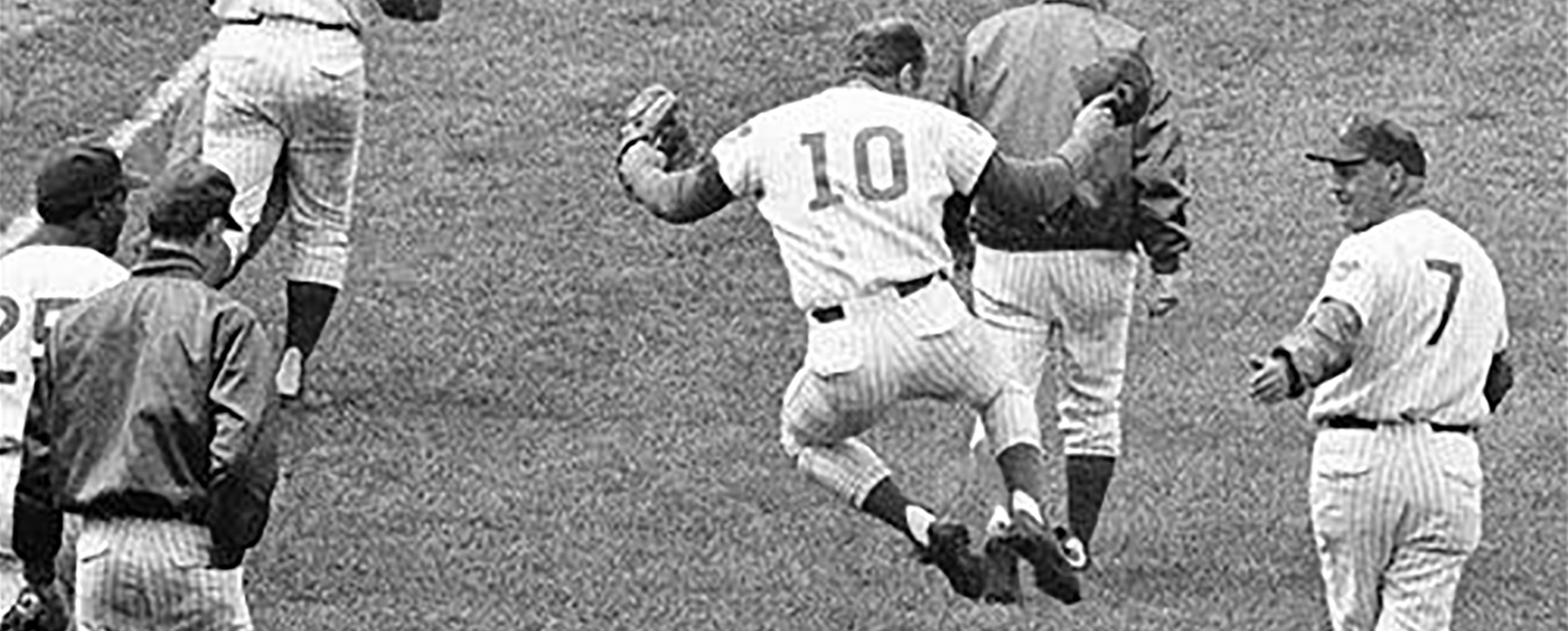
WAR is an interesting metric. It tries to condense a baseball player's contributions into a single estimate of their "Wins Above Replacement," the number of wins a team would gain with this player over a readily available "replacement level player." It is an imperfect metric, but it converts a player's value into a handy universal unit that spans positions and eras. At the end of the day, the goal of a baseball team is to win games. Who is more valuable: a lights-out closer or a hard hitting left fielder? Well, who would contribute more wins than the minor leaguer you could sign for the league minimum instead?
Armed with this information, who would you guess has contributed the most wins above a replacement level player to the Chicago Cubs in the past century1? Ernie Banks? Billy Williams? Someone from 1906 you've never heard of?
That would be my favorite baseball player, Ron Santo.

Figure 1: oWAR and dWAR of every player through the 1960s.
One of the interesting things about baseball is that we have gotten much better at evaluating players over time. This is especially true when it comes to hitters. Practitioners of sabermetrics, the statistical tools that revolutionized baseball, can now measure a hitter's value in incredibly fine detail. A player that years ago might have been celebrated for their high batting average and home run count is now being scrutinized by such esoteric metrics as BABIP, WaaWL%, and rOBA.
But this leads to the opposite phenomenon: hitters that used to be scrutinized for old inaccurate measures of value are now being celebrated by the new ones.
In other words, some players were great and people just didn't notice.
Ron Santo was one of these players.
Baseball Career
It's undeniable that Ron Santo was a fantastic baseball player. He played 15 years in the MLB, 14 of those for the Chicago Cubs. From 1963 through 1969, he was unstoppable. In that seven year time frame, he:
- Received MVP votes every year
- Won five gold gloves in a row
- Was on the all star team six out of seven years
- Missed a grand total of 11 games, less than two a year
And It's not that he was totally underappreciated. In fact, it's quite the opposite: Ron is beloved by Cubs fans. Ask any guy in his 60's walking around the north side of Chicago about the 1969 Cubs and he will tell you all about Ron Santo.
But if you ask this same hypothetical guy who was the best player on that team, he'll likely say Billy Williams. Or Ernie Banks. 2 The fact that Ron Santo not only had the highest WAR on that classic team but also the most in Cubs' history still surprises many people to this day. Ron is thought of more as a good hitter and a great third basemen.
That's the thing about Ron, he wasn't a good hitter. He was a great hitter. One of the best hitters to ever play third base.
Let's talk about some of those fancy sabermetrics. OPS measures a player's on base average (OBP) plus their slugging (SLG), summarizing their overall hitting into a single number. Adjusted OPS+ is an improvement on top of OPS. It better accounts for external influences that can inflate or deflate a hitter's stats. For example some ballparks, famously the "thin-aired" Coors Field in Colorado, are more friendly to hitters than others. OPS+ accounts for these influences.
Second, it normalizes the raw score so the league average is always 100. This allows us to compare players across eras and hitting conditions easily, since it is relative by design. A player with an OPS+ of 100 is always average, a player with an OPS+ of 120 is always 20% better than average, and a player with an OPS+ of 80 likely won't be around for long.
Ron Santo's average OPS+ over that seven year time period (1963-1969) was 144. To put that in perspective, only nine players had a single-year higher OPS+ in the MLB in 2023. He kept it up for seven years.
He suffered from what is now an all too common trope: he was a baseball player who took a lot of walks in an time before we realized those counted too. He was an absolute walk machine. During those aforementioned seven years, he lead the entire national league in walks four times and was only outside of the top five once. It might not have been flashy, but the guy got on base.

Figure 2: Why was Ron Santo such a good hitter?
What made Ron Santo so exceptionally valuable is that he was able to put up those numbers while playing third base. WAR accounts for position when valuing a player's offensive contribution. Being a pitcher who can hit very well is obviously better than being a DH who can hit very well. Same thing goes for third base. If you look at the players who were putting up OPS+ numbers like Ron Santo during this time frame, almost all of them are outfielders.
| Player | OPS+ | Position | dWAR |
|---|---|---|---|
| Mickey Mantle | 177 | CF | -2.0 |
| Boog Powell | 176 | LF | -0.7 |
| Willie Mays | 172 | CF | 2.0 |
| Ron Santo | 164 | 3B | 0.8 |
| Bob Allison | 163 | CF | -0.5 |
But Ron didn't just play third base, he defined the position for a whole generation of fans. This is what most people who watched him play remember. He frequently lead the national league in total chances, putouts, assists, and double plays. He would eventually break the NL record for both career assists and double plays at third base.
In order to understand how good of a hitter Ron was, you needed to understand the value of walks. But to understand how good he was in the field, you could just watch him play.
This is the deadly combination that makes him stand out on a modern stat sheet: hitting like Ron Santo is rare, but hitting like Ron Santo as an five time gold glove infielder is what made him the Chicago Cubs all-time WAR leader.
Struggles with Diabetes
I had to slip into the bathroom each early morning and secretly take my insulin injection. I feared that if the Cubs found out and I slumped badly they would attribute it to the diabetes and send me back to the minors - or worse, release me.
I could stop right there and you might be convinced. This is the great part about Ron. As you dig deeper, it just gets better. Not only was he a great player, he was also a great guy.
Ron was born with Type 1 Diabetes. When he was diagnosed at 18, he was told he had a life expectancy of 25 years. Only four years before he would start his career, diabetes would derail the career of another all-time baseball great: Jackie Robinson.
Diabetes was much less understood in the 1950s and 1960s. Ron spent most of his playing years trying to self-medicate by doing things like eating candy bars in the dug out during games. In the fantastic documentary made about his life, This Old Cub, he recounts having his blood sugar suddenly drop as he was in the on deck circle. He went to bat with blurred vision causing him to see three pitchers out on the mound. He did the logical thing and swang at the middle one: hitting a walk-off homerun.

Figure 3: Ron at the JDRF Walk to Cure Diabetes
The fact that he was a diabetic was not public knowledge until "Ron Santo Day" in 1971, after the bulk of his career was over. Many of his own teammates didn't even know about it. That was, of course, by design. He wanted to show everyone that he was just as good as everyone else, and that having diabetes did not limit him as a player. In doing so, he wanted to set an example for any other kid like him that gets the same diagnosis. They would have someone they could look up to, something that he never had.
Once his career was over, he became an incredibly active force in raising money for JDRF, the Juvenile Diabetes Research Foundation. His "Ron Santo Walk To Cure Diabetes" would raise over $60 million.
Color Commentator
I've been a Cub Fan all my life. I came up here when I was 20 years old and spent my whole career here in Chicago. I've always been an optimist; I believe you have to be in order to survive, to be honest with you - in health, with everything I've been through. That's the way I am.
I could stop there as well. But that would leave out potentially Ron's biggest legacy: being the world's biggest Cubs fan.
I had decided he was my favorite baseball player before really learning anything about his playing career. To me and an entire generation of Cubs' fans, Ron Santo was not just the voice, but the embodiment of the Chicago Cubs.
Him and Pat Hughes were the radio broadcasters for the Cubs from 1996-2010. What made Ron unique was that he was first and foremost a fan. He had a clear enthusiasm for the team that went above and beyond your normal announcer. Some of my favorite calls from Ron are not really calls, but more just the raw sounds of his emotion as the Cubs triumph or (as was much more common) disappoint.
It's hard to capture this in text. As an example, here is Ron's call during a particularly stressful moment during the closing of a tight 1998 playoff race. The person you hear talking initially is Pat Hughes. You will know when you hear Ron Santo.
In that moment, Ron might as well have been watching the game from his couch at home. The pure anguish in that "Oh no" deeply resonated with Cub's fans staring down year 90 of their World Series drought. Pat Hughes would later go on to say that in the silence that followed, Ron had collapsed into his chair with his head in his hands. After the game, he was so distraught that the Cub's manager at the time had to try to cheer him up.
Think about that for a moment: the team's manager had to cheer up the color commentator. It meant that much to him.
At the same time, one of the things that I most remember about his broadcasts is how much fun he was having. He was famous for his tangents and just generally having a good time while broadcasting. Even though he was so invested, he loved baseball and couldn't help from enjoying himself.
Towards the end of his life, Ron's health struggles had increased. In 2001, he had one of his legs amputated and in 2002, the other leg was amputated. He kept broadcasting through all of that. Listening to him you would have had no idea what he was going through. He was just as up beat as ever.
Through all the ups and downs of rooting for the Cubs, Ron was there. Just as deep in it as you were, but still having fun all the same.
Hall of Fame
There is nothing I want more than to be in the Hall of Fame, I wanted it before the surgeries, and I want it now, in just the same way. I've thought a lot about this. It's not just that I want to be in the Hall of Fame. It's that I think I deserve to be there. I accomplished something. It's that part, about deserving to be there, that has stayed with me through all of this. Maybe the idea of dying has affected how I think of the Hall of Fame in a different way. It's difficult to say, in a way. The last thing I want is to die and then be put into the Hall of Fame. It's not because I won't be there to enjoy it, exactly. It's because I want to enjoy it with family and friends and fans. I want to see them enjoy it.
I led this off by calling Ron Santo underrated. I think its time to back that statement up with a lot more than a hypothetical conversation with a 60 year old man. Every baseball fan has their favorite Hall of Fame snub. This, I think, is much worse.
Ron Santo was a great baseball player. He overcame Type 1 Diabetes. He was a beloved announcer for decades. But was he good enough for the Hall of Fame?
JAWS, or the Jaffe WAR Score system, was created to try to take WAR and turn it into a measure of a player's Hall of Fame worthiness. It is the average of a players total career WAR and their WAR7, the combined WAR of their seven best years. In that way, it captures both the quality of the duration of a career and its peak.
The average JAWS of a third basemen in the Hall of Fame is 56.3. Ron Santo has a JAWS of 62.2.
Ron Santo was first eligible to be voted into the hall of fame in 1980. On that ballot he had the second highest JAWS of any player, behind only Al Kaline. Al, rightfully, recieved the highest overall vote total with 340 total votes. Next up was Duke Snider, also well deserving, with 333 votes. These were the only two players on the ballot who recieved enough votes to make it into the hall of fame.
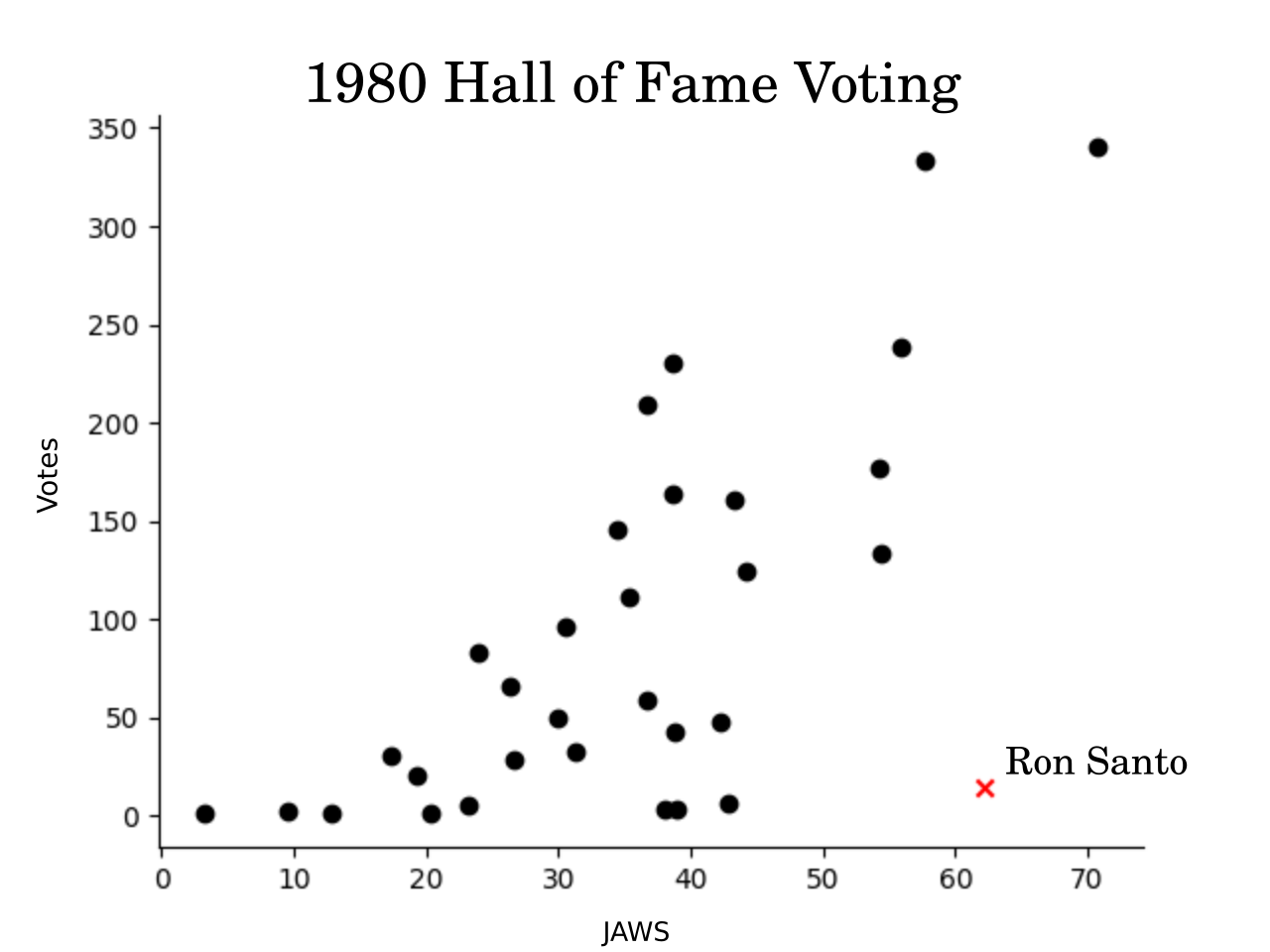
Coming in at 24th place with only 15 votes was Ron Santo.
This was one of the all time Hall of Fame voting snubs. Since 1960 only 10 players with a JAWS over 60 received less than 50% of votes on their first ballot. Almost all of these players were involved in some kind of cheating scandal. Ron Santo received the lowest percentage of votes by a comfortable margin. Pete Rose was literally banned from baseball and still received more votes.
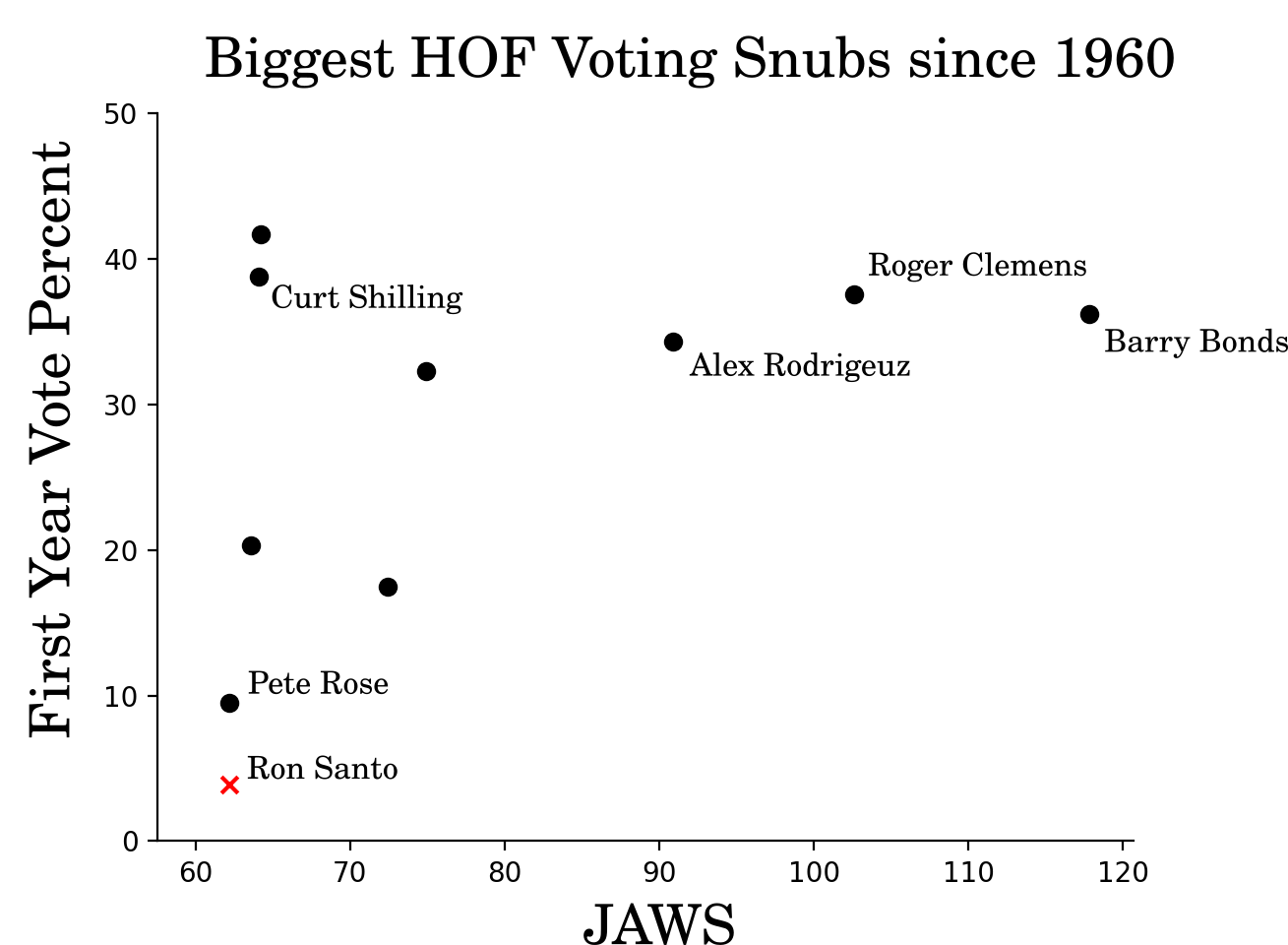
So what happened? There are many reasons why people didn't want to vote for Ron Santo. First and potentially foremost, the Cubs teams he was on never won anything. Not only that, but he played with Billy Williams, Fergie Jenkins, and Ernie Banks: three other Hall of Famers.
Second, there is a bias against third basemen in the Hall of Fame. Currently, there are only 17 players in the Hall that played most of their career at third base. This is the lowest of any position.
There are a lot of arguments you can make but they all boil down to the same thing: the voters just didn't know any better. It's important to remember that JAWS was invented in 2004, and, maybe more importantly, the book Moneyball wouldn't come out until 2003. People were voting before sabermetrics really took hold and an argument around his Adjusted OPS+ wouldn't make any sense.
Everyone knew he was a good player, but they couldn't understand just how good until sabermetrics was able to actually put a number on it. He was simply overlooked.
After some general outcry about the Hall of Fame voting process, Ron Santo (among others) was added back on the ballot in 1985. That year he had the highest overall JAWS. 53 votes. Next year, he was the highest again. 64 votes. From 1985 through 1998, he was never not a top three candidate on the ballot according to JAWS. He never got within 100 votes of being elected.
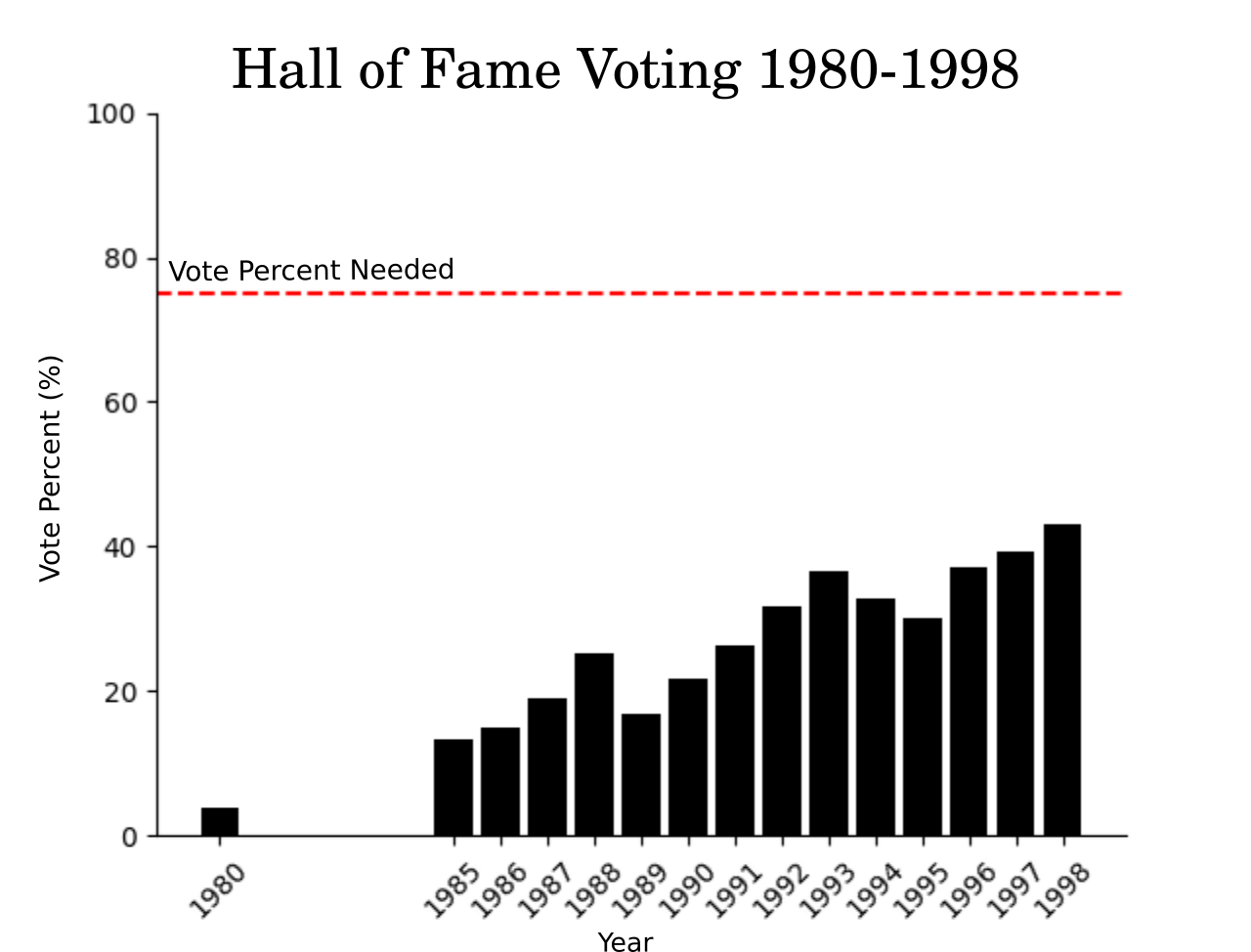
Players who have passed the 15 year limit on the Writer's Ballot still have an alternative route of making it in. There is a "Veterans Committee" that elects players in who've been retired for over 20 years. Starting in 2003, he was being voted on yet again.
The Veterans Commitee was far more favorable to Ron, but with the same ultimate result. In fact, he finished first in their voting three times: 2005, 2007 and 2009. But never with enough votes to actually qualify for the hall.
In 2010 the MLB adjusted the rules yet again, giving him another shot in the 2011 voting process. At this point, the sabermetrics revolution had already run its course and casual fans were talking about things like WAR, OBP and OPS. As this knowledge spread, Ron's Hall of Fame omission was becoming more and more glaring.
The MLB launched a "Golden Era" Hall of Fame committee to focus specifically on the years from 1947-1972. Included in this committee was Cub great and long time teammate of Ron, Billy Williams. He led the charge and emphatically made the case to get Ron elected. After being looked over so many times, the final vote was near unanimous.
30 years overdue, Ron Santo was finally enshrined in the Hall of Fame where he belonged.
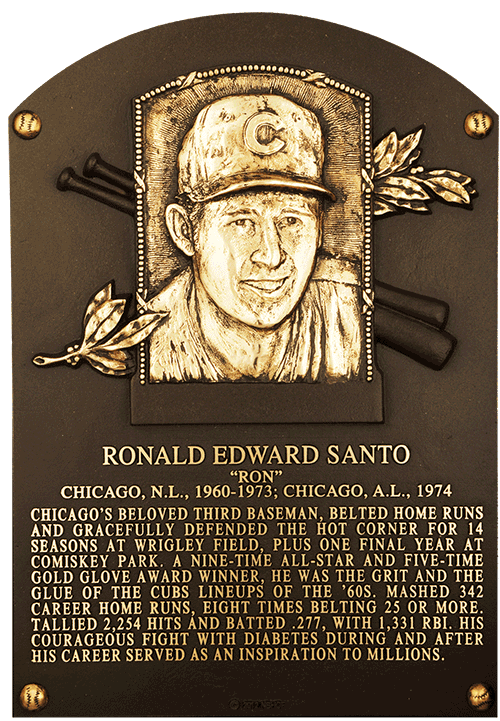
But it was too late. Ron had died barely a year before on December 3rd, 2010 at 70 years old (due in large part to complications from his diabetes). He never got the chance to see himself inducted into the Hall of Fame.
He would be the only player voted in by this committee. They would meet one more time in 2014, elect no one, and be disbanded shortly after. It was almost as if electing Ron had been the entire point of forming it in the first place. A valiant effort to try to unsnub a historic snub.
Ron only ever wanted to see two things: himself in the Hall of Fame and the Cubs winning the world series. In 2016, only six years later, the Cubs would finally end their 107 year drought. He barely missed both.
Number Retirement
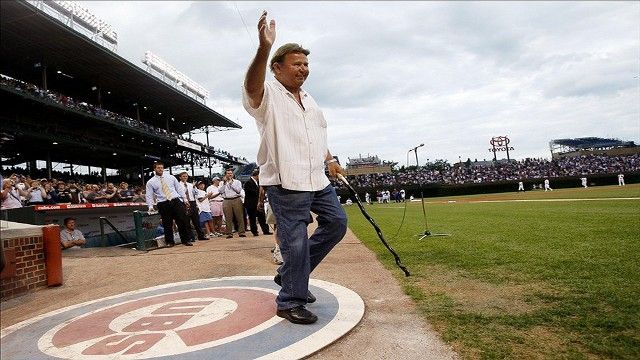
Figure 4: Ron Santo at his number retirement ceremony
You would be remiss if you thought that the life of Ron Santo is some sort of sad story. When he was still playing, Ron Santo was famous for his heel click. It was an spontaneous display of pure joy after a win that quickly came a tradition. I think that shown through in a lot of his life, not only in playing but also in broadcasting. He was a very emotional guy who loved the city of Chicago and the Cubs more than anything else.
That was the whole point, not some trophies or plaques.
On September 28th, 2003 the Chicago Cubs retired Ron Santo's number in a pre-game celebration with his family and friends in attendance. He was just the third player in Cubs history at the time to have his number retired, the other two being his own teammates Ernie Banks and Billy Williams.
As he went up to speak, a guy who made a career out of speaking on the radio was at a loss for words. But I think he was able to find just the right words to describe what it all meant that day:
When I was told that they were going to retire my number, and I mean this sincerely, I thought I had get into the hall of fame to have that done. Because this flag hanging there down the left field line means more to me than the hall of fame.
That is my Hall of Fame.
Thank you, Ron.
Footnotes:
The "past century" disclaimer is necessary only to disqualify "Cap Anson", an incredibly interesting player in his own right. However, his career lasted from 1871-1897 so not exactly a fair comparison.
The 1969 Chicago Cubs had Four Hall of Famers: Ron Santo, Billy Williams, Ferguson Jenkins and Ernie Banks. They somehow managed to not make the playoffs.